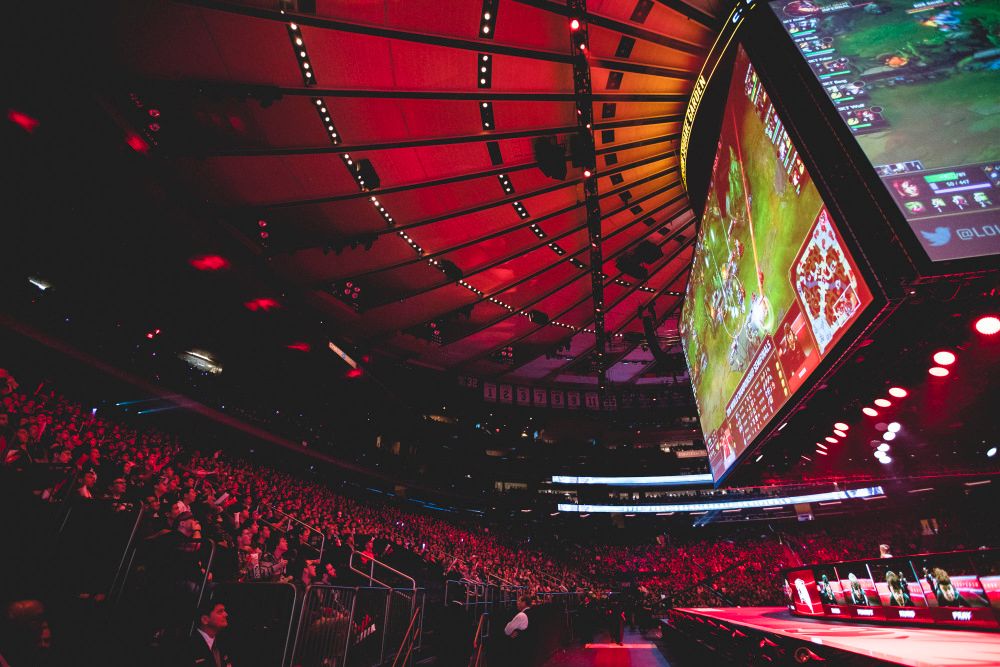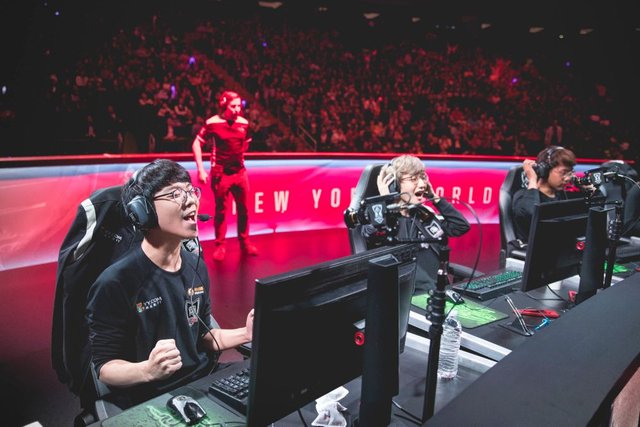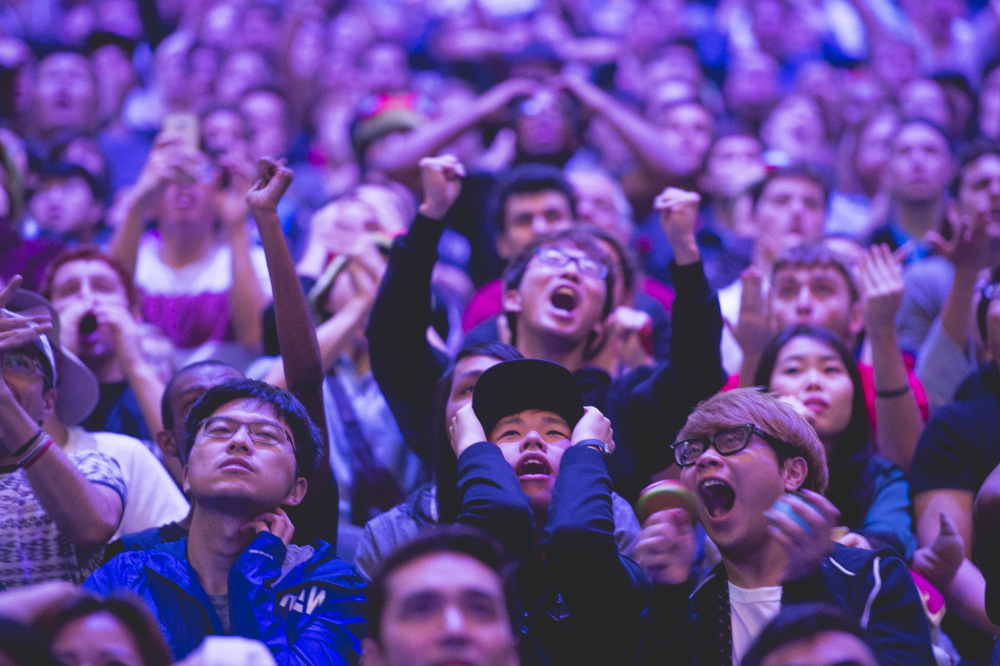League of Legends: How one video game is on its way to becoming the next major worldwide sport
NEW YORK CITY — They showed up hours early, the young people did, dressed in the uniforms of their favorite athletes. (They called them athletes, too, and one day so will you.) The names on the back of the uniforms were unfamiliar and strange, words plucked from the ether – Faker, Wolf, Smeb, GorillA, Cry. Some of the fans were in costume, but most were not. They traveled in packs, mostly boys but some girls as well, walking together in groups of three and four up 8th Avenue toward Madison Square Garden. Here they were, to see their heroes on the biggest stage, at the center of the universe.
It was the League of Legends Semifinals on a Friday night in New York City, and over 15,000 people, young and old, were there to see it all go down. They packed into the arena, giddy and raucous, to watch ten young Korean men play video games against each other. It was Rox Tigers vs. SK Telecom T1, and oh, you should have been there.
If you have been following the business of sports for the past half-decade or so, odds are you’ve stumbled across an article or TV segment on eSports. It’s often framed as something for the future – One day, we will all be watching VIDEO GAMES ON TELEVISION. You may have chuckled at it. Thought “well that will be the day.” Here is the thing though: We are here. That day? Today. We have arrived. eSports are not of the science fiction, and this is no longer the stuff of the future. This is now.
The numbers are staggering. League of Legends, which is merely one video game in a long line of games that are streamed for viewing over the internet, said that over the course of 73 games at last year’s World Championships they averaged 4.2 million viewers watching concurrently, with the average fan watching for “well over an hour per viewing session.” The final of last year’s League of Legends World Championships had 14 million concurrent viewers, roughly the same audience size as Game 1 of last year’s World Series.
Again, League of Legends is one video game. Add in DOTA 2 and CS:GO, the other two big titles in eSports viewership, you’re starting to look at audience sizes that compare to the NFL.
Over the coming week, we here at For The Win will examine this growing world of eSports with a focus on one event – the Friday night semifinal match between Rox Tigers and SK Telecom T1 at Madison Square Garden, a match already being heralded as perhaps the greatest League of Legends match ever played. (The first LoL World Championship was held in 2011, so they feel pretty confident throwing around that sort of hyperbole.) We will try to answer questions: Why is this growing so quickly? Who are these people playing, and watching? Who is protecting them? And where do we go from here?
The match began on Friday night at 6 p.m., and even though it was a semifinal, the pundits — yes, there are pundits – were touting it as the match of the year before it even began. Rox Tigers and SK Telecom T1 are currently the two best LoL (or League as it’s sometimes called) teams in the world. SK Telecom T1, a two-time champion, is led by Faker, a 20-year-old from Seoul who wore glasses, smiled often, and was referred to as “the Michael Jordan of eSports” by just about anyone I spoke to over the weekend.
The players entered the arena to music, bombast, lights and a standing ovation – introduced by Rivington “RivingtonThe3rd” Bisland III, a “caster” and personality who serves as a sort of Jon Gruden-esque figure in the world of LoL. (That is, if Gruden had a better haircut, weighed 145 pounds and dressed sharply in aspirational nerd chic). Bisland is an employee of Riot Games, the company that makes League of Legends and puts on the World Championships every year. He is referred to as “talent” within the company, serving as a face and voice to comment and present the game as a viewing experience to the outside world. He was recognized often throughout the arena that Friday night, with young men shouting “RIV!” at him as he briskly walked by. He smiled and greeted them all.
During the first game of a best-of-5 series, a game SK Telecom T1 won handily in around 40 minutes, Bisland was seated above the action, nestled in a private suite where he could look down upon the players and the action being blasted across the giant video board. For the duration of the 40-minute game (each of the games lasts between 30 and 50 minutes), oftentimes seeming not to take a breath, he spoke about the game he loves so well.
League of Legends is, obviously enough, a video game. It is free, and right now, if the mood should strike, you could go and download it off the internet and be playing in minutes right on your computer. (The game makes its money via “microtransactions” – small payments made by players in order for them to acquire new characters, equipment, and game boosts.)
The game is played by two teams of five players, who start on opposite ends of a map protecting respective bases. The object of the game is simple enough: To win, your team must work together to destroy the other team’s base. Each of the players have different roles based on where they play on the map. Think of it like positions on the field: there are junglers, mid laners, top laners, AD carries, and supports. The map is divided into “lanes” – open paths along the map that connect one base to the other, and battles between the two teams tend to take place in those lanes.
For fans of League of Legends, the above description would be so childish and stupid as to be laughable. There is so much more going on in the game, but describing it all would be like taking an alien from another planet and trying to explain the infield fly rule – it’s just not going to compute. Basically, there are two teams of five and they’re trying to kill each other across a map. Players are constantly working to acquire gold while they’re playing, which can be done in a few different ways, and that gold can then be spent on in-game purchases that help you win. When watching a League match, a good indicator of which team is having more success is the gold count – more gold doesn’t always mean a win is forthcoming, but gain a big enough of a lead in gold and it becomes exceedingly hard for the other team to overcome.

In action, the game is a little bit like a cross between Age of Empires, Magic the Gathering and Super Smash Bros., if older games are more your speed. If even that is gibberish to you, think of it this way – In LoL, fantastical characters (called “champions”) roam around a map, working together to acquire new turf and new equipment, and every once in awhile they come together and beat the everliving hell out of each other. For people who haven’t played the game, the viewing experience is riveting … and completely overwhelming. The learning curve? Almost unbearably steep. Here, for example, is Bisland explaining a particular section of play during the first game of the semifinals:
“So GorillA called to him that ‘I’m here to help,’ but they maybe don’t quite have enough vision on the other team. Actually, there’s hardly any vision on the map right now. If you can see all four triangles, what would be in shade, just of the map, the big quadrants, the bottom right one is a little warded. So you can see vision through there a little bit. It’s not all shadow. But the fact that there’s no vision on the other side for Rox of SKT, means that SKT comes out of the fog, unless they’re in lane farming minions. So, that’s why Peanut was running away like ‘I don’t know what’s going on’ until GorillA came and gave him a shield, and say ‘We don’t have vision, but we know they’re now in our jungle.’”
You get the idea.
Though it is overwhelming, the appeal of League as a viewing experience comes across quickly. The individual games are about the length of a half of soccer, and they take on the rhythm of a soccer match as well. There are moments of calm buildup, during which the audience keeps a watchful eye but can also speak to each other, joke around, sip their beer or Coca Cola. These moments are peppered with skirmishes around the map, but for the most part, the teams are angling for position. (Bisland refers to League as “a cross between a chess match and a boxing match.”) These lulls can last for a few minutes, but every so often, there is a flurry of scoring action as the two teams come together in danger areas. The crowd reacts wildly to these moments – a loud, building hurrahhhh, a sound I’d only ever heard previously at Santiago Bernabéu during a Real Madrid match.
For gamers, too long represented in pop culture as the rejected and lonely, these games provide a coming together. This is a community.
“This becomes your Monday Night Football,” said Bisland. “Families are brought together. Military families, I’ve heard, they come together over this game. Friends are here together, and they might have met each other online playing League, and now they’re traveling together to come to one big event.”

They are here to cheer, and when big moments happen, do they ever. These moments happen organically in individual game, but have also been shepherded in by the game designers. Riot Games noticed in a previous iteration of LoL that top-level players often spent the first 10 or 15 minutes of a game largely ignoring their opponents, which made sense strategically but was a real bummer for fans to watch. So the game designers at Riot changed the way the game was set up. They needed to up the excitement and scoring, so they changed it. Think of it as League’s introduction of the 3-point line.
“For us at Riot, I think we’re the most player-focused company in the world,” said Bisland, toeing the company line. “Obviously, there are changes coming back and forth. Coming into this season, we changed the complete dynamic of the game at the start, much like if you exchanged two queens at the beginning of a game of chess. … [The athletes] got pretty heated, but they saw eventually that it created an incredible viewing experience.”
This all speaks to the constant state of flux for LoL and eSports in general. These leagues aren’t only defining themselves on the fly, they’re often changing the game on the fly, all to find the right balance between fun gameplay for the athletes and fans at home, and a fun viewing experience for the people tuning in for the big matches.
While yes, LoL is definitely going to become huge. I don't believe that it's way alone! CS:GO, DOTA, Rocket League and many else are on that way as well!
Great post! Would you mind if I included it in the "best of gaming" for today?